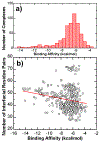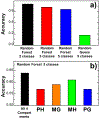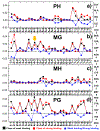A structural-based machine learning method to classify binding affinities between TCR and peptide-MHC complexes
- PMID: 34455212
- PMCID: PMC10811653
- DOI: 10.1016/j.molimm.2021.07.020
A structural-based machine learning method to classify binding affinities between TCR and peptide-MHC complexes
Abstract
The activation of T cells is triggered by the interactions of T cell receptors (TCRs) with their epitopes, which are peptides presented by major histocompatibility complex (MHC) on the surfaces of antigen presenting cells (APC). While each TCR can only recognize a specific subset from a large repertoire of peptide-MHC (pMHC) complexes, it is very often that peptides in this subset share little sequence similarity. This is known as the specificity and cross-reactivity of T cells, respectively. The binding affinities between different types of TCRs and pMHC are the major driving force to shape this specificity and cross-reactivity in T cell recognition. The binding affinities, furthermore, are determined by the sequence and structural properties at the interfaces between TCRs and pMHC. Fortunately, a wealth of data on binding and structures of TCR-pMHC interactions becomes publicly accessible in online resources, which offers us the opportunity to develop a random forest classifier for predicting the binding affinities between TCR and pMHC based on the structure of their complexes. Specifically, the structure and sequence of a given complex were projected onto a high-dimensional feature space as the input of the classifier, which was then trained by a large-scale benchmark dataset. Based on the cross-validation results, we found that our machine learning model can predict if the binding affinity of a given TCR-pMHC complex is stronger or weaker than a predefined threshold with an overall accuracy approximately around 75 %. The significance of our prediction was estimated by statistical analysis. Moreover, more than 60 % of binding affinities in the ATLAS database can be successfully classified into groups within the range of 2 kcal/mol. Additionally, we show that TCR-pMHC complexes with strong binding affinity prefer hydrophobic interactions between amino acids with large aromatic rings instead of electrostatic interactions. Our results therefore provide insights to design engineered TCRs which enhance the specificity for their targeted epitopes. Taken together, this method can serve as a useful addition to a suite of existing approaches which study binding between TCR and pMHC.
Keywords: Binding affinity; Random forest classifier; TCR-pMHC complexes.
Copyright © 2021 Elsevier Ltd. All rights reserved.
Conflict of interest statement
Figures






Similar articles
-
Multi-positive contrastive learning-based cross-attention model for T cell receptor-antigen binding prediction.Comput Methods Programs Biomed. 2025 Aug;268:108797. doi: 10.1016/j.cmpb.2025.108797. Epub 2025 May 10. Comput Methods Programs Biomed. 2025. PMID: 40378554
-
MPID-T: database for sequence-structure-function information on T-cell receptor/peptide/MHC interactions.Appl Bioinformatics. 2006;5(2):111-4. doi: 10.2165/00822942-200605020-00005. Appl Bioinformatics. 2006. PMID: 16722775
-
Engineering improved T cell receptors using an alanine-scan guided T cell display selection system.J Immunol Methods. 2013 Jun 28;392(1-2):1-11. doi: 10.1016/j.jim.2013.02.018. Epub 2013 Mar 13. J Immunol Methods. 2013. PMID: 23500145 Free PMC article.
-
Modulation of T cell function by TCR/pMHC binding kinetics.Immunobiology. 2006;211(1-2):47-64. doi: 10.1016/j.imbio.2005.09.003. Epub 2006 Jan 4. Immunobiology. 2006. PMID: 16446170 Review.
-
Structural basis for self-recognition by autoimmune T-cell receptors.Immunol Rev. 2012 Nov;250(1):32-48. doi: 10.1111/imr.12002. Immunol Rev. 2012. PMID: 23046121 Review.
Cited by
-
TCR-like antibodies targeting autoantigen-mhc complexes: a mini-review.Front Immunol. 2022 Jul 27;13:968432. doi: 10.3389/fimmu.2022.968432. eCollection 2022. Front Immunol. 2022. PMID: 35967436 Free PMC article. Review.
-
TCR-H: explainable machine learning prediction of T-cell receptor epitope binding on unseen datasets.Front Immunol. 2024 Aug 16;15:1426173. doi: 10.3389/fimmu.2024.1426173. eCollection 2024. Front Immunol. 2024. PMID: 39221256 Free PMC article.
-
TCR-pMHC Binding Specificity Prediction From Structure Using Graph Neural Networks.IEEE Trans Comput Biol Bioinform. 2025 Jan-Feb;22(1):171-179. doi: 10.1109/TCBBIO.2024.3504235. IEEE Trans Comput Biol Bioinform. 2025. PMID: 40811222
-
A B7-H3-Targeted CD28 Bispecific Antibody Enhances the Activity of Anti-PD-1 and CD3 T-cell Engager Immunotherapies.Mol Cancer Ther. 2025 Mar 4;24(3):331-344. doi: 10.1158/1535-7163.MCT-24-0327. Mol Cancer Ther. 2025. PMID: 39301613 Free PMC article.
-
Large-scale template-based structural modeling of T-cell receptors with known antigen specificity reveals complementarity features.Front Immunol. 2023 Aug 15;14:1224969. doi: 10.3389/fimmu.2023.1224969. eCollection 2023. Front Immunol. 2023. PMID: 37649481 Free PMC article.
References
Publication types
MeSH terms
Substances
Grants and funding
LinkOut - more resources
Full Text Sources
Research Materials

